|
|
|
Gardilanne (Gratiane de), Moffat (Elisabeth Whitney)
Les costumes régionaux de France. - L'Artois. Pêcheuse de Saint-Pol.
français 38x25 [51,5x35 cm]. "Maquettes originales exécutées par Gratiane De Gardilanne et Elisabeth Whitney Moffat. Les originaux ont été offerts au Metroplitan Museum of Fine Arts, New York par une donatrice qui a désiré garder l'anonymat. Les reproductions sont l'oeuvre de la Maison Daniel Jacomet à Paris. Elles ont été imprimées en phototypie de couleurs, rehaussées d'environ trente pochoirs et retouchées à la main. Le travail de surveillance a été l'objet des soins tout particuliers de Henry Royère. Le papier des planches vient de l'Union des Papeteries Françaises à Paris. Les passe-partout sont fabriqués par la Maison Félix à Paris. Le tirage a été limité à 500 exemplaires dont 100 réservés aux Etats-Unis." Très bel état. Petits accroc dans la partie inférieure du passe-partout.
|
|
|
Gardilanne (Gratiane de), Moffat (Elisabeth Whitney)
Les costumes régionaux de France. - L'Artois. Pêcheuse de vers du littoral.
français 38x24,5 [51,5x35 cm]. "Maquettes originales exécutées par Gratiane De Gardilanne et Elisabeth Whitney Moffat. Les originaux ont été offerts au Metroplitan Museum of Fine Arts, New York par une donatrice qui a désiré garder l'anonymat. Les reproductions sont l'oeuvre de la Maison Daniel Jacomet à Paris. Elles ont été imprimées en phototypie de couleurs, rehaussées d'environ trente pochoirs et retouchées à la main. Le travail de surveillance a été l'objet des soins tout particuliers de Henry Royère. Le papier des planches vient de l'Union des Papeteries Françaises à Paris. Les passe-partout sont fabriqués par la Maison Félix à Paris. Le tirage a été limité à 500 exemplaires dont 100 réservés aux Etats-Unis." Très bel état.
|
|
|
Gardilanne (Gratiane de), Moffat (Elisabeth Whitney)
Les costumes régionaux de France. - L'Auvergne. Danseuse du Puy.
français 38x24,5 [51,5x35 cm]. "Maquettes originales exécutées par Gratiane De Gardilanne et Elisabeth Whitney Moffat. Les originaux ont été offerts au Metroplitan Museum of Fine Arts, New York par une donatrice qui a désiré garder l'anonymat. Les reproductions sont l'oeuvre de la Maison Daniel Jacomet à Paris. Elles ont été imprimées en phototypie de couleurs, rehaussées d'environ trente pochoirs et retouchées à la main. Le travail de surveillance a été l'objet des soins tout particuliers de Henry Royère. Le papier des planches vient de l'Union des Papeteries Françaises à Paris. Les passe-partout sont fabriqués par la Maison Félix à Paris. Le tirage a été limité à 500 exemplaires dont 100 réservés aux Etats-Unis."
|
|
|
Gardilanne (Gratiane de), Moffat (Elisabeth Whitney)
Les costumes régionaux de France. - L'Auvergne. Jeune fille des environs de Clermont-Ferrand.
français 38x25 [51,5x35 cm]. "Maquettes originales exécutées par Gratiane De Gardilanne et Elisabeth Whitney Moffat. Les originaux ont été offerts au Metroplitan Museum of Fine Arts, New York par une donatrice qui a désiré garder l'anonymat. Les reproductions sont l'oeuvre de la Maison Daniel Jacomet à Paris. Elles ont été imprimées en phototypie de couleurs, rehaussées d'environ trente pochoirs et retouchées à la main. Le travail de surveillance a été l'objet des soins tout particuliers de Henry Royère. Le papier des planches vient de l'Union des Papeteries Françaises à Paris. Les passe-partout sont fabriqués par la Maison Félix à Paris. Le tirage a été limité à 500 exemplaires dont 100 réservés aux Etats-Unis." Très bel état.
|
|
|
Gardilanne (Gratiane de), Moffat (Elisabeth Whitney)
Les costumes régionaux de France. - L'Auvergne. Paysan de Saint-Bonnet.
français 38x25 [51,5x35 cm]. "Maquettes originales exécutées par Gratiane De Gardilanne et Elisabeth Whitney Moffat. Les originaux ont été offerts au Metroplitan Museum of Fine Arts, New York par une donatrice qui a désiré garder l'anonymat. Les reproductions sont l'oeuvre de la Maison Daniel Jacomet à Paris. Elles ont été imprimées en phototypie de couleurs, rehaussées d'environ trente pochoirs et retouchées à la main. Le travail de surveillance a été l'objet des soins tout particuliers de Henry Royère. Le papier des planches vient de l'Union des Papeteries Françaises à Paris. Les passe-partout sont fabriqués par la Maison Félix à Paris. Le tirage a été limité à 500 exemplaires dont 100 réservés aux Etats-Unis." Très bel état.
|
|
|
Gardilanne (Gratiane de), Moffat (Elisabeth Whitney)
Les costumes régionaux de France. - L'orléanais. Femme de Chartres.
français 38x25 [51,5x35 cm]. "Maquettes originales exécutées par Gratiane De Gardilanne et Elisabeth Whitney Moffat. Les originaux ont été offerts au Metroplitan Museum of Fine Arts, New York par une donatrice qui a désiré garder l'anonymat. Les reproductions sont l'oeuvre de la Maison Daniel Jacomet à Paris. Elles ont été imprimées en phototypie de couleurs, rehaussées d'environ trente pochoirs et retouchées à la main. Le travail de surveillance a été l'objet des soins tout particuliers de Henry Royère. Le papier des planches vient de l'Union des Papeteries Françaises à Paris. Les passe-partout sont fabriqués par la Maison Félix à Paris. Le tirage a été limité à 500 exemplaires dont 100 réservés aux Etats-Unis." Infime accroc dans la planche.
|
|
|
Gardilanne (Gratiane de), Moffat (Elisabeth Whitney)
Les costumes régionaux de France. - L'Orléanais. Jeune femme des environs d'Orléans.
français 38x25 [51,5x35 cm]. "Maquettes originales exécutées par Gratiane De Gardilanne et Elisabeth Whitney Moffat. Les originaux ont été offerts au Metroplitan Museum of Fine Arts, New York par une donatrice qui a désiré garder l'anonymat. Les reproductions sont l'oeuvre de la Maison Daniel Jacomet à Paris. Elles ont été imprimées en phototypie de couleurs, rehaussées d'environ trente pochoirs et retouchées à la main. Le travail de surveillance a été l'objet des soins tout particuliers de Henry Royère. Le papier des planches vient de l'Union des Papeteries Françaises à Paris. Les passe-partout sont fabriqués par la Maison Félix à Paris. Le tirage a été limité à 500 exemplaires dont 100 réservés aux Etats-Unis." Très bel état.
|
|
|
Gardilanne (Gratiane de), Moffat (Elisabeth Whitney)
Les costumes régionaux de France. - La Champagne. Femme des environs d'Argeville.
français 38x25 [51,5x35 cm]. "Maquettes originales exécutées par Gratiane De Gardilanne et Elisabeth Whitney Moffat. Les originaux ont été offerts au Metroplitan Museum of Fine Arts, New York par une donatrice qui a désiré garder l'anonymat. Les reproductions sont l'oeuvre de la Maison Daniel Jacomet à Paris. Elles ont été imprimées en phototypie de couleurs, rehaussées d'environ trente pochoirs et retouchées à la main. Le travail de surveillance a été l'objet des soins tout particuliers de Henry Royère. Le papier des planches vient de l'Union des Papeteries Françaises à Paris. Les passe-partout sont fabriqués par la Maison Félix à Paris. Le tirage a été limité à 500 exemplaires dont 100 réservés aux Etats-Unis." Très bel état.
|
|
|
Gardilanne (Gratiane de), Moffat (Elisabeth Whitney)
Les costumes régionaux de France. - La Normandie. Jeune femme de Deauville.
français 38x25 [51,5x35 cm]. "Maquettes originales exécutées par Gratiane De Gardilanne et Elisabeth Whitney Moffat. Les originaux ont été offerts au Metroplitan Museum of Fine Arts, New York par une donatrice qui a désiré garder l'anonymat. Les reproductions sont l'oeuvre de la Maison Daniel Jacomet à Paris. Elles ont été imprimées en phototypie de couleurs, rehaussées d'environ trente pochoirs et retouchées à la main. Le travail de surveillance a été l'objet des soins tout particuliers de Henry Royère. Le papier des planches vient de l'Union des Papeteries Françaises à Paris. Les passe-partout sont fabriqués par la Maison Félix à Paris. Le tirage a été limité à 500 exemplaires dont 100 réservés aux Etats-Unis." Très bel état.
|
|
|
Gardilanne (Gratiane de), Moffat (Elisabeth Whitney)
Les costumes régionaux de France. - La Normandie. Vieille femme de la vallée de la Touques.
français 38x25 [51,5x35 cm]. "Maquettes originales exécutées par Gratiane De Gardilanne et Elisabeth Whitney Moffat. Les originaux ont été offerts au Metroplitan Museum of Fine Arts, New York par une donatrice qui a désiré garder l'anonymat. Les reproductions sont l'oeuvre de la Maison Daniel Jacomet à Paris. Elles ont été imprimées en phototypie de couleurs, rehaussées d'environ trente pochoirs et retouchées à la main. Le travail de surveillance a été l'objet des soins tout particuliers de Henry Royère. Le papier des planches vient de l'Union des Papeteries Françaises à Paris. Les passe-partout sont fabriqués par la Maison Félix à Paris. Le tirage a été limité à 500 exemplaires dont 100 réservés aux Etats-Unis." Très bel état.
|
|
|
Gardilanne (Gratiane de), Moffat (Elisabeth Whitney)
Les costumes régionaux de France. - La Normandie. Cauchoise du Bois d'Ennebourg.
français 38x24,5 [51,5x35 cm]. "Maquettes originales exécutées par Gratiane De Gardilanne et Elisabeth Whitney Moffat. Les originaux ont été offerts au Metroplitan Museum of Fine Arts, New York par une donatrice qui a désiré garder l'anonymat. Les reproductions sont l'oeuvre de la Maison Daniel Jacomet à Paris. Elles ont été imprimées en phototypie de couleurs, rehaussées d'environ trente pochoirs et retouchées à la main. Le travail de surveillance a été l'objet des soins tout particuliers de Henry Royère. Le papier des planches vient de l'Union des Papeteries Françaises à Paris. Les passe-partout sont fabriqués par la Maison Félix à Paris. Le tirage a été limité à 500 exemplaires dont 100 réservés aux Etats-Unis." Très bel état.
|
|
|
Gardilanne (Gratiane de), Moffat (Elisabeth Whitney)
Les costumes régionaux de France. - La Normandie. Dieppoise en costume de travail.
français 38x25 [51,5x35 cm]. "Maquettes originales exécutées par Gratiane De Gardilanne et Elisabeth Whitney Moffat. Les originaux ont été offerts au Metroplitan Museum of Fine Arts, New York par une donatrice qui a désiré garder l'anonymat. Les reproductions sont l'oeuvre de la Maison Daniel Jacomet à Paris. Elles ont été imprimées en phototypie de couleurs, rehaussées d'environ trente pochoirs et retouchées à la main. Le travail de surveillance a été l'objet des soins tout particuliers de Henry Royère. Le papier des planches vient de l'Union des Papeteries Françaises à Paris. Les passe-partout sont fabriqués par la Maison Félix à Paris. Le tirage a été limité à 500 exemplaires dont 100 réservés aux Etats-Unis." Très bel état.
|
|
|
Gardilanne (Gratiane de), Moffat (Elisabeth Whitney)
Les costumes régionaux de France. - La Normandie. Pêcheuse du Polet au travail ; port de Dieppe.
français 38x25 [51,5x35 cm]. "Maquettes originales exécutées par Gratiane De Gardilanne et Elisabeth Whitney Moffat. Les originaux ont été offerts au Metroplitan Museum of Fine Arts, New York par une donatrice qui a désiré garder l'anonymat. Les reproductions sont l'oeuvre de la Maison Daniel Jacomet à Paris. Elles ont été imprimées en phototypie de couleurs, rehaussées d'environ trente pochoirs et retouchées à la main. Le travail de surveillance a été l'objet des soins tout particuliers de Henry Royère. Le papier des planches vient de l'Union des Papeteries Françaises à Paris. Les passe-partout sont fabriqués par la Maison Félix à Paris. Le tirage a été limité à 500 exemplaires dont 100 réservés aux Etats-Unis." Très bel état.
|
|
|
Gardilanne (Gratiane de), Moffat (Elisabeth Whitney)
Les costumes régionaux de France. - La Savoie. Enfant de Saint-Jean-d'Arves.
français 38x24 [51,5x35 cm]. "Maquettes originales exécutées par Gratiane De Gardilanne et Elisabeth Whitney Moffat. Les originaux ont été offerts au Metroplitan Museum of Fine Arts, New York par une donatrice qui a désiré garder l'anonymat. Les reproductions sont l'oeuvre de la Maison Daniel Jacomet à Paris. Elles ont été imprimées en phototypie de couleurs, rehaussées d'environ trente pochoirs et retouchées à la main. Le travail de surveillance a été l'objet des soins tout particuliers de Henry Royère. Le papier des planches vient de l'Union des Papeteries Françaises à Paris. Les passe-partout sont fabriqués par la Maison Félix à Paris. Le tirage a été limité à 500 exemplaires dont 100 réservés aux Etats-Unis." Très bel état.
|
|
|
Gardilanne (Gratiane de), Moffat (Elisabeth Whitney)
Les costumes régionaux de France. - Le Comté de Foix. Marié de Massat.
français 38x25 [51,5x35 cm]. "Maquettes originales exécutées par Gratiane De Gardilanne et Elisabeth Whitney Moffat. Les originaux ont été offerts au Metroplitan Museum of Fine Arts, New York par une donatrice qui a désiré garder l'anonymat. Les reproductions sont l'oeuvre de la Maison Daniel Jacomet à Paris. Elles ont été imprimées en phototypie de couleurs, rehaussées d'environ trente pochoirs et retouchées à la main. Le travail de surveillance a été l'objet des soins tout particuliers de Henry Royère. Le papier des planches vient de l'Union des Papeteries Françaises à Paris. Les passe-partout sont fabriqués par la Maison Félix à Paris. Le tirage a été limité à 500 exemplaires dont 100 réservés aux Etats-Unis." Très bel état.
|
|
|
Gardilanne (Gratiane de), Moffat (Elisabeth Whitney)
Les costumes régionaux de France. - Le Comté de Nice. Femme de pêcheur du littoral.
français 38x24,5 [51,5x35 cm]. "Maquettes originales exécutées par Gratiane De Gardilanne et Elisabeth Whitney Moffat. Les originaux ont été offerts au Metroplitan Museum of Fine Arts, New York par une donatrice qui a désiré garder l'anonymat. Les reproductions sont l'oeuvre de la Maison Daniel Jacomet à Paris. Elles ont été imprimées en phototypie de couleurs, rehaussées d'environ trente pochoirs et retouchées à la main. Le travail de surveillance a été l'objet des soins tout particuliers de Henry Royère. Le papier des planches vient de l'Union des Papeteries Françaises à Paris. Les passe-partout sont fabriqués par la Maison Félix à Paris. Le tirage a été limité à 500 exemplaires dont 100 réservés aux Etats-Unis." Très bel état.
|
|
|
Gardilanne (Gratiane de), Moffat (Elisabeth Whitney)
Les costumes régionaux de France. - Le Comté de Nice. Pêcheuse de Nice.
français 38x24,5 [51,5x35 cm]. "Maquettes originales exécutées par Gratiane De Gardilanne et Elisabeth Whitney Moffat. Les originaux ont été offerts au Metroplitan Museum of Fine Arts, New York par une donatrice qui a désiré garder l'anonymat. Les reproductions sont l'oeuvre de la Maison Daniel Jacomet à Paris. Elles ont été imprimées en phototypie de couleurs, rehaussées d'environ trente pochoirs et retouchées à la main. Le travail de surveillance a été l'objet des soins tout particuliers de Henry Royère. Le papier des planches vient de l'Union des Papeteries Françaises à Paris. Les passe-partout sont fabriqués par la Maison Félix à Paris. Le tirage a été limité à 500 exemplaires dont 100 réservés aux Etats-Unis." Très bel état.
|
|
|
Gardilanne (Gratiane de), Moffat (Elisabeth Whitney)
Les costumes régionaux de France. - Le Comté de Nice. Fleuriste de Nice.
français 38x24,5 [51,5x35 cm]. "Maquettes originales exécutées par Gratiane De Gardilanne et Elisabeth Whitney Moffat. Les originaux ont été offerts au Metroplitan Museum of Fine Arts, New York par une donatrice qui a désiré garder l'anonymat. Les reproductions sont l'oeuvre de la Maison Daniel Jacomet à Paris. Elles ont été imprimées en phototypie de couleurs, rehaussées d'environ trente pochoirs et retouchées à la main. Le travail de surveillance a été l'objet des soins tout particuliers de Henry Royère. Le papier des planches vient de l'Union des Papeteries Françaises à Paris. Les passe-partout sont fabriqués par la Maison Félix à Paris. Le tirage a été limité à 500 exemplaires dont 100 réservés aux Etats-Unis." Très bel état.
|
|
|
Gaston CHAISSAC
Belle affiche, en parfait état, de l'exposition GASTON CHAISSAC qui s'est tenu à Avignon, au Grenier à sel, du 15 août au 26 octobre 2003 En feuille Très bon Avignon 2003 60 x 40 cm
Bookseller reference : 13449
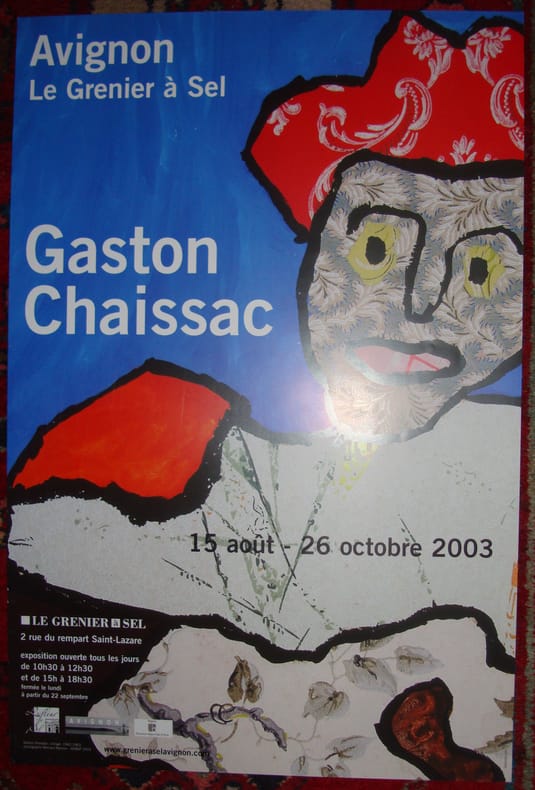
|
|
|
GASC. PÉZENAS.-
Affiche en couleurs Pépinières Gasc Pézenas. Dormez sur vos deux oreilles, les pépinières Gasc feront le reste.-
Béziers. Affiches Alquié. Vers 1920?. Affiche de 615 x 835 mm en couleurs, représentant une jeune femme endormie au milieu de grappes de raisin et de feuilles de vigne. Bords lgt fendillés, traces légères de plis mais assez bon état.
Bookseller reference : ORD-15933
|
|
|
GASTRONOMIE. DIJON.-
Affiche Visitez la Foire Gastronomique de Dijon, 12 novembre 1922.-
Lyon. Affiches Cohendet. (1922). Affiche couleurs, entoilée, 77 x 119 cm, montrant un cuisinier en tenue devant une table somptueusement garnie. Restaurations. Assez bon état. Photo sur demande.
Bookseller reference : ORD-16690
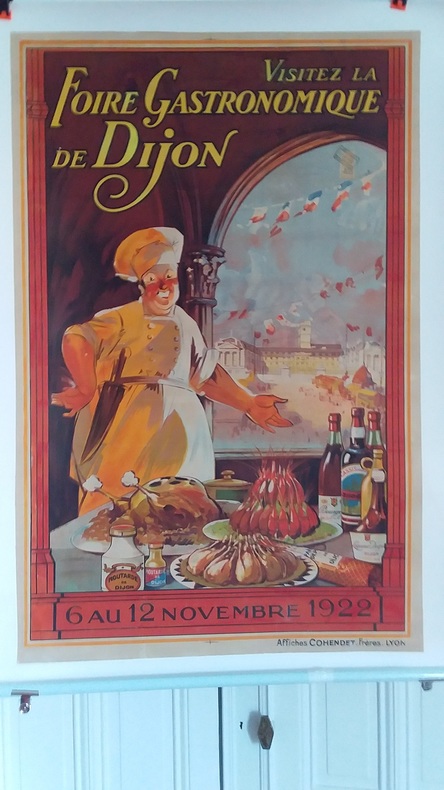
|
|
|
GASQUET (Vasco).
Les 500 affiches de mai 68.
Paris Balland 1978 1 vol. broché in-8, broché, couverture illustrée, 220 pp., nombreuses reproductions en noir et rouge. Très bon état.
Bookseller reference : 115035
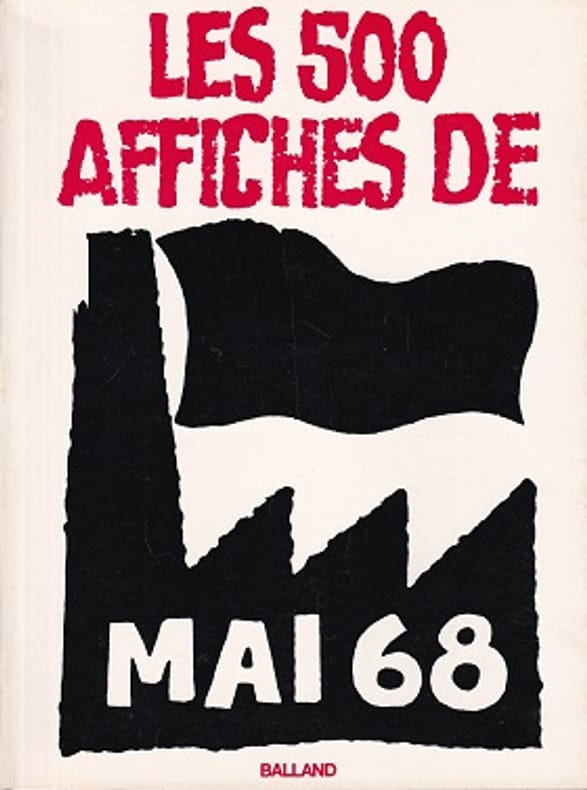
|
|
|
GASQUET (Vasco).
Les 500 affiches de mai 68.
Paris Balland 1978 1 vol. broché in-8, broché, couverture illustrée, 220 pp., nombreuses reproductions en noir et rouge. Très bon état.
Bookseller reference : 115035

|
|
|
GAS (André).
Menu illustré d'une gravure originale signée.
Paris Les Impénitents 1968 4 vol. Broché Menu dépliant sur Arches illustré d'une eau-forte tirée en rouge (22.5 x 14 cm) signée par André Gas, avec grand dessin original signé au verso. On joint deux belles cartes de voeux de l'artiste pour 1969 et 1970 (photomontages avec perforations, ainsi qu'une grande gravure signée en épreuve d'artiste intitule "La foire aux santons" (22 x 27 cm). Diplômé de l'Ecole des Beaux-Arts de Paris en 1969 (section gravure), André Gas s'est lancé la même année dans la création de bijoux fantaisie, développant à Marseille une entreprise qui compte aujourd'hui plus de cent salariés. Bel ensemble.
Bookseller reference : 109180
|
|
|
GAS (André).
Menu illustré d'une gravure originale signée.
Paris Les Impénitents 1968 4 vol. Broché Menu dépliant sur Arches illustré d'une eau-forte tirée en rouge (22.5 x 14 cm) signée par André Gas, avec grand dessin original signé au verso. On joint deux belles cartes de voeux de l'artiste pour 1969 et 1970 (photomontages avec perforations, ainsi qu'une grande gravure signée en épreuve d'artiste intitule "La foire aux santons" (22 x 27 cm). Diplômé de l'Ecole des Beaux-Arts de Paris en 1969 (section gravure), André Gas s'est lancé la même année dans la création de bijoux fantaisie, développant à Marseille une entreprise qui compte aujourd'hui plus de cent salariés. Bel ensemble.
Bookseller reference : 109180
|
|
|
Gasser, Manuel
Herbert Leupin. Plakate. Posters.
Zürich u. Frankfurt a. M., Hans Rudolf Hug, 1957. Gross-4°. (11) S. Mit 24 farb., mont. Illustr. u. 1 gef., farb. Poster in Weltformat von Herbert Leupin. Orig.-Heft u. lose Tafeln in farb. illustr. Orig.-Umschlag + Wichtig: Für unsere Kunden in der EU erfolgt der Versand alle 14 Tage verzollt ab Deutschland / Postbank-Konto in Deutschland vorhanden + (hint. Gelenk über 5 cm geplatzt, rechte Umschlagklappe mit 2 x 2 cm Einriss).
Bookseller reference : 4655BB
|
|
|
GASSIER Henry-Paul Deyvaux-Gasier, dit Henry-Paul
Dessin original à l'encre noire représentant son ami le caricaturiste, scénariste et cinéaste Carlo Rim
- s.l. 1925, 13,5x11cm, une feuille. - Dessin original à l'encre noire représentant en buste Carlo Rim habillé en smocking et noeud papillon, un fume-cigarette aux lèvres. Un morceau d'un autre feuillet a été encollé en marge gauche inférieure du dessin enrichi de cet envoi autographe signé de H. P. Gassier : "A Rim bien amicalement HP Gassier.", Carlo Rim ayant ajouté en marge droite du dessin au crayon de papier : "Carlo Rim par HP Gassier 1925". Carlo Rim fut un écrivain provençal "Ma belle Marseille", un caricaturiste, un cinéaste et fut notamment l'ami de Fernandel, de Raimu et Marcel Pagnol mais aussi de Max Jacob et André Salmon qu'il rencontra à Sanary. Henry-Paul Deyvaus-Gassier fut un illustrateur et journaliste français qui participa à la création du Canard enchaîné en 1915. [ENGLISH DESCRIPTION ON DEMAND]

|
|
|
GASSIER Henry-Paul Deyvaux-Gasier, dit Henry-Paul
Humoristique lettre autographe signée à son grand ami Carlo Rim enrichie de trois dessins originaux en couleurs
- s.l. 22 Juin 1923, 15x20cm, une feuille. - Humoristique lettre autographe signée à son grand ami Carlo Rim enrichie de trois dessins originaux en couleurs sous forme de rébus, 32 lignes à l'encre noire. Dans cette lettre, Henry-Paul Gassier se moque gentiment de son ami Carlo Rim : "Carlo Rim aimait trop les rébus... mais Carlo Rim ne savait pas traduire les rébus..." et "Carlo Rim prétend être devenu fou en essayant de déchiffrer des rébus qu'H.P.G. avait faits pour éprouver sa force. Carlo Rim est un satané menteur...", "... mais Carlo Rim a une grande paresse d'esprit... Et si ça n'est pas vrai, c'est qu'alors Carli Rim est parfaitement idiot..." Carlo Rim fut un écrivain provençal, auteur de "Ma belle Marseille", un caricaturiste, un cinéaste et fut notamment l'ami de Fernandel, de Raimu et Marcel Pagnol mais aussi de Max Jacob et André Salmon qu'il rencontra à Sanary. [ENGLISH DESCRIPTION ON DEMAND]

|
|
|
Gatti (Armand) J. Mascii
L'enclos.
français Sans date. Affiche originale du film. 120x160 cm (approximatif). Pliée, petites usures et coupures dans les plis, un manque de papier au coin supérieur droit.
|
|
|
GAUTHIER (Albert)
"Jean Mermoz" posa pour "Albert Gauthier", à 34 ans. LE voici d'après le bois gravé de l'artiste. Affiche lithographiée, monogramme et date dans la composition en bas à droite.
Sans nom d'éditeur,, (vers 1935). 44 x 64 cm à la feuille.
Bookseller reference : 31816
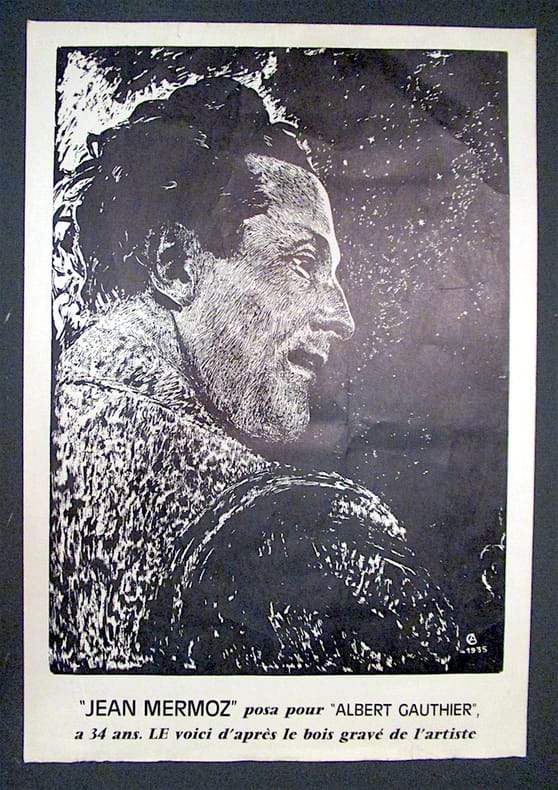
|
|
|
GAUTIER (Théophile). GANCE (Abel).
Le Capitaine Fracasse.
1942 Lavis aquarelle et gouache signé du monogramme de l'artiste en bas à gauche, titré, 1942, 43 x 32.5 cm.
Bookseller reference : 23461
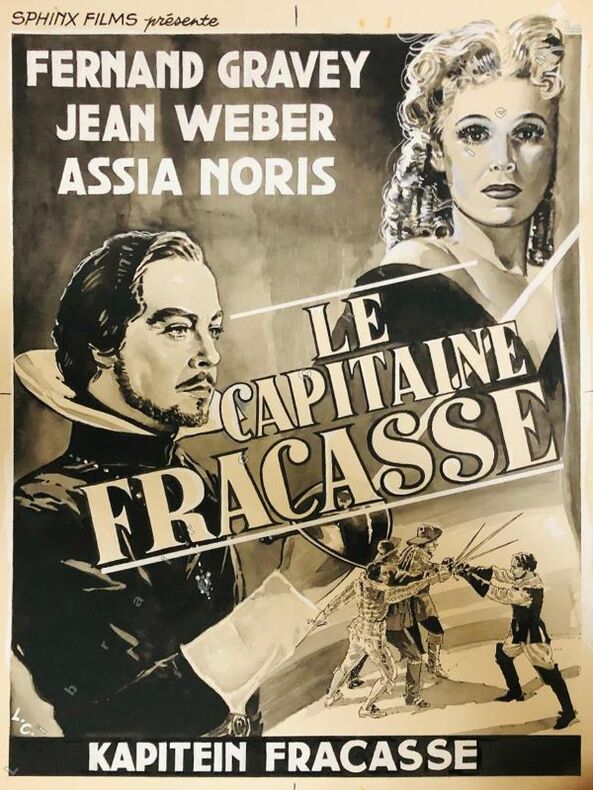
|
|
|
Gauld Tom:
Move to the city.
B.ü.L.b comix, 2004. Grande affiche (68 x 100 cm.) présentant le livre éponyme du génialissime dessinateur anglais. A l'état de neuf.
Bookseller reference : 2882
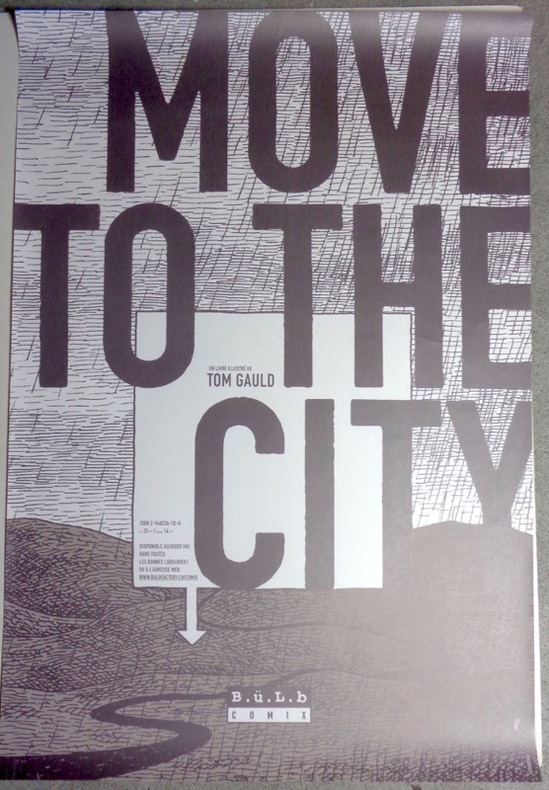
|
|
|
GAUTRAND jean-claude
Publicités Kodak 1910-1939
Contrejour. 1983. In-4. Relié. Bon état, Couv. convenable, Dos satisfaisant, Intérieur frais. 79 pages. Tampons et couverture de bibliothèque. De très nombreuses illustrations hors et dans le texte noires et couleur.. . . . Classification Dewey : 741.67-Illustrations des affiches
Bookseller reference : RO80000050
|
|
|
GAUGUIN Paul & MONFREID George-Daniel de
Diane et Actéon aux Marquises. Noa Noa. Epreuve unique du bois dessiné et gravé d'après Paul Gauguin par George-Daniel de Monfreid
- s.d. (1924), 93x78mm, autre. - Diane et Actéon aux Marquises. Noa Noa. Unique proof of the woodcut drawn and engraved after Paul Gauguin by George-Daniel de Monfreid [between 1904 & 1924] | 9,3 x 7,8 mm | one sheet Original proof, likely unique, of this intermediate state of a woodcut drawn and engraved by George-Daniel de Monfreid after two works by Paul Gauguin. Print on Japan silk, annotation by the artist in the left-hand margin. Woodcut drawn and engraved after two works, the man holding a branch being a reproduction of a watercolor on page 37 of the Noa Noa manuscript, while the full-length woman originally observed by this browser, is presented here in bust with her hand to her face, model reproduced on a woodcut engraved by Gauguin on page 4 of the manuscript (and his original sketch pasted on page 51), evoking a similar scene. The final woodcut will serve as the head of chapter IV of the first true illustrated edition of Noa Noa, published by Crès in 1924, the first illustrated work after Paul Gauguin and a majestic tribute to one of the precursors of modern art. Superb engraving synthesizing a watercolor from the original Noa Noa manuscript, inspired by the myth of Diana and Actaeon, engraved by Gauguin's closest friend and executor, the artist George-Daniel de Monfreid, heir to the album he would offer to the French State in 1927. A likely unique proof, part of 17 known test woodcuts from the early project to publish Noa Noa, all made on various fine papers and annotated by the artist. Woodcut engraved after a watercolor reinterpreting the myth of Diana, surprised in the bath by Actaeon. In the engraving, Monfreid took care to preserve the typical of deer antler shape of the branch seized by the indiscreet, which evokes its metamorphosis by the goddess. A very rare work by Gauguin mixing ancient mythology and island exoticism, whose subversive power seems entirely carried by the vahine Diana's expression of feint surprise. It is from the original illustrated manuscript of Noa Noa, brought back from Tahiti by Segalen on the artist's death in 1903, that Monfreid began producing this fundamental work from as early as 1904. This is the second version of this "to read and look at" notebook. The first manuscript, written on the return of his first voyage and entrusted by Gauguin to Charles Morice in 1893, responded to a different project. Gauguin had composed only the text, interspersed with blank pages for Morice's poems. But after several years without news, Morice preferred to publish a version entirely rewritten by himself in 1901. Gauguin, therefore, copied his manuscript and illustrated it during his second stay in Polynesia, with sketches, watercolors and collages. This album, that the artist enriched and safely preserved until his death, is preserved today at the Musée d'Orsay. It is, therefore, from this manuscript, the only one illustrated, that Monfreid composed the edition of Gauguin's Noa Noa. However, although Monfreid's publication was forward, it took more than twenty years to complete, in part due to a copyright dispute with Charles Morice who wanted to be co-author of the forthcoming edition and whose poems would eventually be preserved. The result of several years of reflection and work, the 1924 edition is both faithful to the watercolors and woodcut engravings illustrating the precious manuscript, and to the whole of Gauguin's Tahitian work, who died in indifference. Monfreid thus engraves several drawings from the original notebook and enriches it with woodcuts made from other works of which he is the custodian. Some of these compositions combine several paintings, while scrupulously respecting the artist's line, transforming the work into a true journey through the painter's works. The very choice of using wood engraving is a tribute to this technique prized by Gauguin, who, in Pont-Aven, produced 10 woodcuts to illustrate his manuscript between his two Polynesian stays. The interm

|
|
|
GAUGUIN Paul & MONFREID George-Daniel de
La mémoire et l'imagination. Noa Noa. Epreuve unique du bois dessiné et gravé d'après Paul Gauguin par George-Daniel de Monfreid
- s.d. (1924), 93x78mm, autre. - La Mémoire et l'Imagination. Noa Noa. Unique proof of the woodcut drawn and engraved after Paul Gauguin by George-Daniel de Monfreid [between 1904 & 1924] | 9,3 x 7,8 cm | one sheet Original proof, likely unique, of this intermediate state of a woodcut drawn and engraved by George-Daniel de Monfreid after a watercolor by Paul Gauguin. Print on fine cream laid paper, annotation by the artist in the left-hand margin. Woodcut drawn and engraved after a watercolor from the Noa Noa manuscript, pasted on a page of text of the famous album. The final woodcut will serve as the head of the first illustrated edition of Noa Noa, published by Crès in 1924, the first illustrated work after Paul Gauguin and a majestic tribute to one of the precursors of modern art. Superb and significant engraving after a very specific watercolor from Paul Gauguin's manuscript, a real breakthrough in text, engraved by his closest friend and executor, the artist George-Daniel de Monfreid, heir to the album he would offer to the French State in 1927. The initial watercolor was cut out in waves around the female figure and pasted on the last chapter to prevent it from being read and thus get the story back on track. Gauguin had also added winding lines starting from the watercolor on the text page, thus giving the impression of a cave breaking through the page, by the psychic power of the sitting woman whose head diffuses the undulating rays. Monfreid decided to place it at the head of the work accompanied by two birds taken from other works, to illustrate the power of the artist and his imagination. A likely unique proof, part of 17 known test woodcuts from the early project to publish Noa Noa, all made on various fine papers and annotated by the artist. Unique proof of a woodcut engraved after the mystical watercolor erasing the first ending of the story to allow the reader to graphically enter the painted album, repeated in the printed version as the initiatory opening of the engraved story. It is from the original illustrated manuscript of Noa Noa, brought back from Tahiti by Segalen on the artist's death in 1903, that Monfreid began producing this fundamental work from as early as 1904. This is the second version of this "to read and look at" notebook. The first manuscript, written on the return of his first voyage and entrusted by Gauguin to Charles Morice in 1893, responded to a different project. Gauguin had composed only the text, interspersed with blank pages for Morice's poems. But after several years without news, Morice preferred to publish a version entirely rewritten by himself in 1901. Gauguin, therefore, copied his manuscript and illustrated it during his second stay in Polynesia, with sketches, watercolors and collages. This album, that the artist enriched and safely preserved until his death, is preserved today at the Musée d'Orsay. It is, therefore, from this manuscript, the only one illustrated, that Monfreid composed the edition of Gauguin's Noa Noa. However, although Monfreid's publication was forward, it took more than twenty years to complete, in part due to a copyright dispute with Charles Morice who wanted to be co-author of the forthcoming edition and whose poems would eventually be preserved. The result of several years of reflection and work, the 1924 edition is both faithful to the watercolors and woodcut engravings illustrating the precious manuscript, and to the whole of Gauguin's Tahitian work, who died in indifference. Monfreid thus engraves several drawings from the original notebook and enriches it with woodcuts made from other works of which he is the custodian. Some of these compositions combine several paintings, while scrupulously respecting the artist's line, transforming the work into a true journey through the painter's works. The very choice of using wood engraving is a tribute to this technique prized by Gauguin, who, in Pont-Aven, produced 10 woodcuts to illu

|
|
|
GAUGUIN Paul & MONFREID George-Daniel de
Les odalisques aux mangues. Noa Noa. Epreuve unique du bois dessiné et gravé d'après Paul Gauguin par George-Daniel de Monfreid
- s.d. (1924), 93x78mm, autre. - Les Odalisques aux mangues. Noa Noa. Unique proof of the woodcut drawn and engraved after Paul Gauguin by George-Daniel de Monfreid [between 1904 & 1924] | 9,3 x 7,8 cm | one sheet Original proof, likely unique, of this intermediate state of a woodcut drawn and engraved by George-Daniel de Monfreid after Paul Gauguin. Print on fine cream laid paper, annotation by the artist in the left-hand margin. Woodcut drawn and engraved after two different works. The back of the woman is an exact reproduction of an ink from page 92 of the Noa Noa manuscript, while the woman lying down takes up the well-known theme of the woman with mangos, Te Arii Vahine-Opoi, that Gauguin represented in paint as well as with an engraving in 1898. The final woodcut will serve as the head of chapter V of the first true illustrated edition of Noa Noa, published by Crès in 1924, the first illustrated work from Paul Gauguin and a majestic tribute to one of the precursors of modern art. Superb and significant engraving uniting two major themes of the Tahitian work, including the central drawing of the Noa Noa manuscript, faithfully engraved by Gauguin's closest friend and executor, the artist George-Daniel de Monfreid. A likely unique proof, part of 17 known test woodcuts from the project to prematurely publish Noa Noa, all made on various fine papers and annotated by the artist. Woodcut engraved from two major original works. By uniting these two vahines with sensual postures, Monfreid brings about a true synthesis of Gauguin's work, all while using the traditional double figure of the artist's paintings. It is from the original illustrated manuscript of Noa Noa, brought back from Tahiti by Segalen on the artist's death in 1903, that Monfreid began producing this fundamental work from as early as 1904. This is the second version of this "to read and look at" notebook. The first manuscript, written on the return of his first voyage and entrusted by Gauguin to Charles Morice in 1893, responded to a different project. Gauguin had composed only the text, interspersed with blank pages for Morice's poems. But after several years without news, Morice preferred to publish a version entirely rewritten by himself in 1901. Gauguin, therefore, copied his manuscript and illustrated it during his second stay in Polynesia, with sketches, watercolors and collages. This album, that the artist enriched and safely preserved until his death, is preserved today at the Musée d'Orsay. It is, therefore, from this manuscript, the only one illustrated, that Monfreid composed the edition of Gauguin's Noa Noa. However, although Monfreid's publication was forward, it took more than twenty years to complete, in part due to a copyright dispute with Charles Morice who wanted to be co-author of the forthcoming edition and whose poems would eventually be preserved. The result of several years of reflection and work, the 1924 edition is both faithful to the watercolors and woodcut engravings illustrating the precious manuscript, and to the whole of Gauguin's Tahitian work, who died in indifference. Monfreid thus engraves several drawings from the original notebook and enriches it with woodcuts made from other works of which he is the custodian. Some of these compositions combine several paintings, while scrupulously respecting the artist's line, transforming the work into a true journey through the painter's works. The very choice of using wood engraving is a tribute to this technique prized by Gauguin, who, in Pont-Aven, produced 10 woodcuts to illustrate his manuscript between his two Polynesian stays. The intermediate woodcuts, until then unknown, testify to the slow work of composition to restore the artistic richness of Gauguin's work by his most faithful artistic companion and first champion: "When I saw Gauguin for the first time, I was greatly disconcerted by the details of art that radiated from his works as well as from the conversations

|
|
|
GAUGUIN Paul & MONFREID George-Daniel de
Retour de pêche aux thons et bonites. Noa Noa. Epreuve unique du bois dessiné et gravé d'après Paul Gauguin par George-Daniel de Monfreid
- s.d. (1924), 93x78mm, autre. - Retour de pêche aux thons et bonites. Noa Noa. Unique proof of the woodcut drawn and engraved after Paul Gauguin by George-Daniel de Monfreid [between 1904 & 1924] | 9,3 x 7,8 cm | one sheet Original proof, likely unique, of this intermediate state of a woodcut drawn and engraved by George-Daniel de Monfreid after a watercolor by Paul Gauguin. Print on fine cream laid paper, annotation by the artist in the left-hand margin. Woodcut drawn and engraved from the first watercolor of the Noa Noa manuscript, pasted on a page of text of the famous album. The final woodcut will serve as the head of chapter X of the first true illustrated edition of Noa Noa, published by Crès in 1924, the first illustrated work from Paul Gauguin and a majestic tribute to this precursor of modern art. Superb and significant engraving of the work opening Paul Gauguin's manuscript, engraved by his closest friend and executor, the artist George-Daniel de Monfreid, heir to the album he would offer to the French State in 1927. This likely unique proof, part of 17 known test woodcuts from the project to prematurely publish Noa Noa, all made on various fine papers and annotated by the artist. Woodcut engraved from the watercolor inaugurating one of the painter's most beautiful albums, symbolizing the Tahitian art of living, between the nourishing sea and earthly pleasures. It is from the original illustrated manuscript of Noa Noa, brought back from Tahiti by Segalen on the artist's death in 1903, that Monfreid began producing this fundamental work from as early as 1904. This is the second version of this "to read and look at" notebook. The first manuscript, written on the return of his first voyage and entrusted by Gauguin to Charles Morice in 1893, responded to a different project. Gauguin had composed only the text, interspersed with blank pages for Morice's poems. But after several years without news, Morice preferred to publish a version entirely rewritten by himself in 1901. Gauguin, therefore, copied his manuscript and illustrated it during his second stay in Polynesia, with sketches, watercolors and collages. This album, that the artist enriched and safely preserved until his death, is preserved today at the Musée d'Orsay. It is, therefore, from this manuscript, the only one illustrated, that Monfreid composed the edition of Gauguin's Noa Noa. However, although Monfreid's publication was forward, it took more than twenty years to complete, in part due to a copyright dispute with Charles Morice who wanted to be co-author of the forthcoming edition and whose poems would eventually be preserved. The result of several years of reflection and work, the 1924 edition is both faithful to the watercolors and woodcut engravings illustrating the precious manuscript, and to the whole of Gauguin's Tahitian work, who died in indifference. Monfreid thus engraves several drawings from the original notebook and enriches it with woodcuts made from other works of which he is the custodian. Some of these compositions combine several paintings, while scrupulously respecting the artist's line, transforming the work into a true journey through the painter's works. The very choice of using wood engraving is a tribute to this technique prized by Gauguin, who, in Pont-Aven, produced 10 woodcuts to illustrate his manuscript between his two Polynesian stays. The intermediate woodcuts, until then unknown, testify to the slow work of composition to restore the artistic richness of Gauguin's work by his most faithful artistic companion and first champion: "When I saw Gauguin for the first time, I was greatly disconcerted by the details of art that radiated from his works as well as from the conversations of this extraordinary man... You immediately felt that he was the Master" (in L'Hermitage, 1903). [FRENCH VERSION FOLLOWS] Epreuve originale probablement unique de cet état intermédiaire d'un bois dessiné et gravé d'après une aquarel

|
|
|
GAUGUIN Paul & MONFREID George-Daniel de
Tehura. Noa Noa. Epreuve unique gravée d'après le tableau Merahi metua no tehamana de Paul Gauguin par George-Daniel de Monfreid
- s.d. (1924), 93x78mm, autre. - Tehura. Original proof engraved after the painting "Merahi Metua no Tehamana". Intermediate state for Noa Noa [between 1904 & 1924] | 9,3 x 7,8 cm | one sheet Original proof, likely unique, of this intermediate state of "Tehura", wood drawn and engraved after Paul Gaughin's painting "Merahi Metua no Tehamana" by George-Daniel de Monfreid. Print on fine cream laid paper, annotation by the artist in the left-hand margin. The definitive wood served as the head of chapter VI, "Le Conteur parle", page 81 of the true first edition of Noa Noa published by Crès in 1924, the first illustrated work from Paul Gauguin and a majestic tribute to one of the precursors of modern art. A most important and very first woodcut of Gauguin's masterpiece, engraved by his closest friend and executor, artist George-Daniel de Monfreid, to whom Gauguin offered the painting after two unsuccessful exhibitions. Likely unique proof, part of 17 known test prints from the project to publish prematurely Noa Noa, all made on various fine papers and annotated by the artist. Precious woodcut after Gauguin's masterpiece Merahi metua no Tehamana, showing the painter's wife, his main tahitian model. It is from the original illustrated manuscript of Noa Noa, brought back from Tahiti by Segalen on the artist's death in 1903, that Monfreid began producing this fundamental work from as early as 1904. This is the second version of this "to read and look at" notebook. The first manuscript, written on the return of his first voyage and entrusted by Gauguin to Charles Morice in 1893, responded to a different project. Gauguin had composed only the text, interspersed with blank pages for Morice's poems. But after several years without news, Morice preferred to publish a version entirely rewritten by himself in 1901. Gauguin, therefore, copied his manuscript and illustrated it during his second stay in Polynesia, with sketches, watercolors and collages. This album, that the artist enriched and safely preserved until his death, is preserved today at the Musée d'Orsay. It is, therefore, from this manuscript, the only one illustrated, that Monfreid composed the edition of Gauguin's Noa Noa. However, although Monfreid's publication was forward, it took more than twenty years to complete, in part due to a copyright dispute with Charles Morice who wanted to be co-author of the forthcoming edition and whose poems would eventually be preserved. The result of several years of reflection and work, the 1924 edition is both faithful to the watercolors and woodcut engravings illustrating the precious manuscript, and to the whole of Gauguin's Tahitian work, who died in indifference. Monfreid thus engraves several drawings from the original notebook and enriches it with woodcuts made from other works of which he is the custodian. Some of these compositions combine several paintings, while scrupulously respecting the artist's line, transforming the work into a true journey through the painter's works. The very choice of using wood engraving is a tribute to this technique prized by Gauguin, who, in Pont-Aven, produced 10 woodcuts to illustrate his manuscript between his two Polynesian stays. The intermediate woodcuts, until then unknown, testify to the slow work of composition to restore the artistic richness of Gauguin's work by his most faithful artistic companion and first champion: "When I saw Gauguin for the first time, I was greatly disconcerted by the details of art that radiated from his works as well as from the conversations of this extraordinary man... You immediately felt that he was the Master" (in L'Hermitage, 1903). [FRENCH VERSION FOLLOWS] Epreuve originale probablement unique de cet état intermédiaire de "Tehura", bois dessiné et gravé d'après le tableau Merahi metua no tehamana de Paul Gauguin par Georges-Daniel de Monfreid. Tirage sur vergé crème fin, annotation de l'artiste au crayon en marge gauche. Le bois définitif servira

|
|
|
Gavarni
Femme assise.
français Slnd. Dessin original à la mine de plomb.20 x 15,5 cm Signé par Gavarni.
|
|
|
GAVARNI Paul
Fourberies de femmes
- Aubert et Cie, Paris s.d. (1840), 27x34cm, 52 lithographies reliées en un volume. - Fourberies de femmes Aubert et Cie | Paris [1840] | 27 x 34 cm 52 lithographs bound together in half shagreen Full sets of 52 original lithographs enhanced by hand with colour and varnish, first printing. These engravings were initially published in La Caricature. Contemporary binding in half brown shagreen, spine lightly faded and decorated with gilt fillets and fleurons, black morocco library label at the foot, glued paper endpapers, the first with a title label framed with a double gilt fillet, caillouté marbled endpapers. Upper corners lightly damaged, margins and spine ends a little rubbed. Some discreet foxing mainly on the first board. A worm hole filled with a piece of paper on the lower margin of the twenty-first print. Plate 38 is little shorter than the others on the external margin. [FRENCH VERSION FOLLOWS] Série complète de 52 lithographies originales rehaussées en couleurs et gommées, toutes en premier tirage. Ces gravures sont primitivement parues dans La Caricature. Reliure de l'époque en demi chagrin marron, dos lisse légèrement éclairci orné de filets et fleurons dorés, étiquette de bibliothèque de maroquin noir en queue, plats de papier à la colle, le premier comportant une étiquette de titre encadrée d'un double filet doré, gardes et contreplats de papier caillouté. Coins supérieurs légèrement accidentés, coupes et coiffes un peu frottées. Quelques discrètes rousseurs essentiellement sur la première planche. Une galerie de ver comblée à l'aide d'une pièce de papier en marge basse de la vingt-et-unième estampe. La planche 38 est un peu plus courte que les autres en marge extérieure.

|
|
|
GAVARNI Paul
Lithographie originale en couleurs - "De l'esprit et du pain pour un jour."
- Imprimerie d'Aubert, Paris s.d. [1839], 26,4x34,5cm, une feuille. - Lithographie originale réhaussée en couleurs et gommée, pour Le Charivari, imprimée sur papier fin. Armelhaut et Bocher 904. Planche uniformément ombrée. [ENGLISH DESCRIPTION ON DEMAND]

|
|
|
GAZOLINE
1977 Affiche originale 1977 1200x780mmGroupe de punk rock français formé en 1977, composé entre autres d'Alain Kan et de Fred Chichin. Son nom est un hommage au mouvement féministe Gazolines, fondé par Maud Molyneux, Patrick Bertaux et Paquita Paquin.(104354)
Bookseller reference : 104354
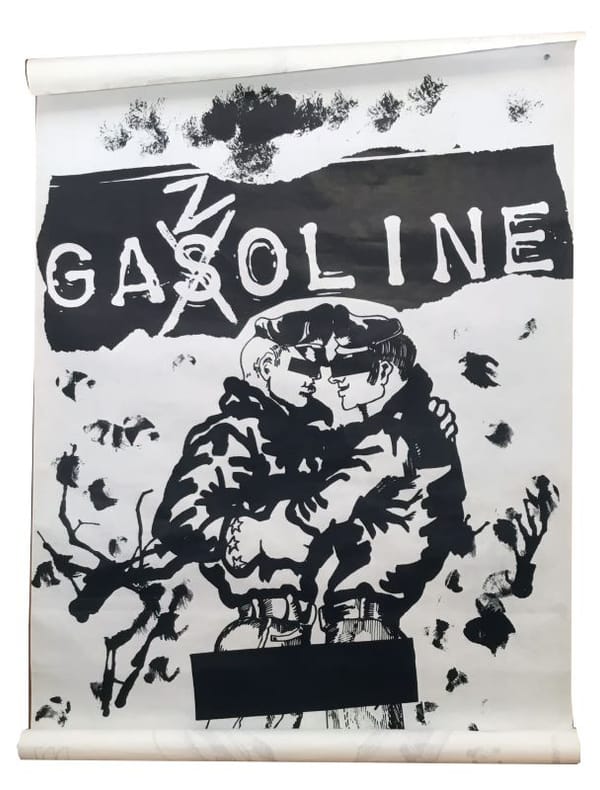
|
|
|
GAËTAN-PICON, Geneviève. - WEILL, Alain
Charles Loupot. Musée de l’Affiche, 18 rue de Paradis, Paris 10°.
La Tour-de-Peilz, sans date, vers 1979 210x250mm, broché. Format à l’italienne. Petite déchirure sur le coin supérieur de la couverture supérieure et manque la page de titre, autrement bel exemplaire.
Bookseller reference : 80106
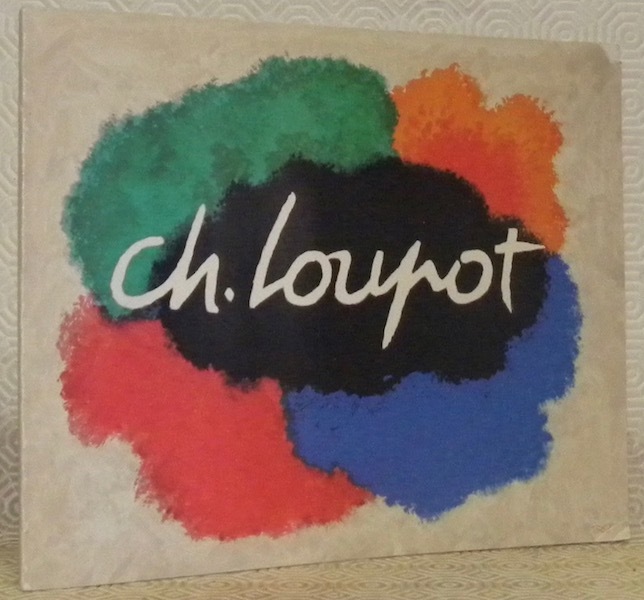
|
|
|
GEFFROY & CORIANDRE George
(Le Génie de la montagne in La Gazette du bon ton n°3, 1924-25 - 7ème année. )
- Lucien Vogel éditeur, Paris 1924-1925, 18x24,5cm, deux doubles feuillets. - Extrait original tiré de La Gazette du bon ton, illustré de huit dessins en couleurs de Geffroy. On y joint un double feuillet de texte concernant la mode d'hiver chez différents créateurs (Lanvin, Poiret, Vionnet et Worth). Célèbre revue de mode fondée en 1912 par Lucien Vogel, La Gazette du bon ton a paru jusqu'en 1925 avec une interruption durant la Guerre de 1915 à 1920, pour cause de mobilisation de son rédacteur en chef. Elle se constitue de 69 livraisons tirées à seulement 2000 exemplaires et est illustrée notamment de 573 planches en couleurs et de 148 croquis représentant des modèles de grands couturiers. Dès leur parution, ces luxueuses publications « s'adressent aux bibliophiles et aux mondains esthètes » (Françoise Tétart-Vittu « La Gazette du bon ton » in Dictionnaire de la mode, 2016). Imprimées sur beau papier vergé, elles utilisent une police typographique spécialement créée pour la revue par Georges Peignot, le caractère Cochin, repris en 1946 par Christian Dior. Les estampes sont réalisées grâce à la technique du pochoir métallique, rehaussées en couleurs et pour certaines soulignées à l'or ou au palladium. L'aventure commence en 1912 lorsque Lucien Vogel, homme du monde et de la mode - il a déjà participé à la revue Femina - décide de fonder avec sa femme Cosette de Brunhoff (sur de Jean, le père de Babar) La Gazette du bon ton dont le sous-titre est alors « Art, modes et frivolités ». Georges Charensol rapporte les propos du rédacteur en chef : « En 1910, observe-t-il, il n'existait aucun journal de mode véritablement artistique et représentatif de l'esprit de son époque. Je songeais donc à faire un magazine de luxe avec des artistes véritablement modernes [...] J'étais certain du succès car pour la mode aucun pays ne peut rivaliser avec la France. » (« Un grand éditeur d'art. Lucien Vogel » in Les Nouvelles littéraires, n°133, mai 1925). Le succès de la revue est immédiat, non seulement en France, mais aussi aux Etats-Unis et en Amérique du Sud. À l'origine, Vogel réunit donc un groupe de sept artistes : André-Édouard Marty et Pierre Brissaud, suivis de Georges Lepape et Dammicourt ; et enfin ses amis de l'École des beaux-arts que sont George Barbier, Bernard Boutet de Monvel, ou Charles Martin. D'autres talents viennent rapidement rejoindre l'équipée : Guy Arnoux, Léon Bakst, Benito, Boutet de Monvel, Umberto Brunelleschi, Chas Laborde, Jean-Gabriel Domergue, Raoul Dufy, Édouard Halouze, Alexandre Iacovleff, Jean Émile Laboureur, Charles Loupot, Charles Martin, Maggie Salcedo. Ces artistes, inconnus pour la plupart lorsque Lucien Vogel fait appel à eux, deviendront par la suite des figures artistiques emblématiques et recherchées. Ce sont ces mêmes illustrateurs qui réalisent les dessins des publicités de la Gazette. Les planches mettent en lumière et subliment les robes de sept créateurs de l'époque : Lanvin, Doeuillet, Paquin, Poiret, Worth, Vionnet et Doucet. Les couturiers fournissent pour chaque numéro des modèles exclusifs. Néanmoins, certaines des illustrations ne figurent aucun modèle réel, mais seulement l'idée que l'illustrateur se fait de la mode du jour. La Gazette du bon ton est une étape décisive dans l'histoire de la mode. Alliant l'exigence esthétique et l'unité plastique, elle réunit pour la première fois les grands talents du monde des arts, des lettres et de la mode et impose, par cette alchimie, une toute nouvelle image de la femme, élancée, indépendante et audacieuse, également portée par la nouvelle génération de couturiers Coco Chanel, Jean Patou, Marcel Rochas... Reprise en 1920 par Condé Montrose Nast, La Gazette du bon ton inspirera largement la nouvelle composition et les choix esthétiques du « petit journal mourant » que Nast avait racheté quelques années auparavant : le magazine Vogue. Très bel exemplaire. [ENGLISH DESCRIPTION ON DEMAND]

|
|
|
Geiger, Mizzi
Spanischer Zirkus. Münchner Carneval im Tattersall Leopoldstr. 93.
München, Oscar Consee A.G. Kunstanstalt, 1928. Farb. lithogr. Plakat (120 x 85,5 cm).
Bookseller reference : 65885
|
|
|
Geis, Josef
??Jugend? Fest [Jugendfest] im Theatersaal der Luitpoldbetriebe?.
München, G. Hirth Verlag, 1930. Farb. Plakat, im Druck signiert ?Geis 30? (?Linoldruck?; 118 x 85 cm).
Bookseller reference : 65769

|
|
|
Geldmacher, Klaus
licht- und ton-objekte. 1969. [Plakat, Farboffset / poster, offset print].
o.J. Klaus Geldmacher, geboren am 25. Januar 1940 in Frankfurt am Main, deutscher Objektkünstler.
Bookseller reference : 9942DB

|
|
|
GENE KELLY - DEBBIE REYNOLDS - DONALD O'CONNORD
AFFICHE DE CINEMA - CHANTONS SOUS LA PLUIE
STANLEY DONEN. Non daté. In-12. Broché. Bon état, Couv. convenable, Dos satisfaisant, Intérieur frais. Affiche de cinéma 60 cm x 80 cm.. . . . Classification : 0-Affiches Cinéma
Bookseller reference : R100000366
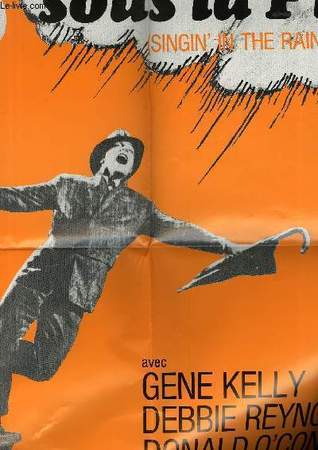
|
|
|
GENIS (René) -
Affiche lithographiée -
Paris : impression Art-Estampe, 1988 - affiche lithographiée, 49 x 58 cm - Affiche de l'exposition de la Galerie des Chaudronniers à Genève en avril-juin 1988 - très bon état -
Bookseller reference : 12289
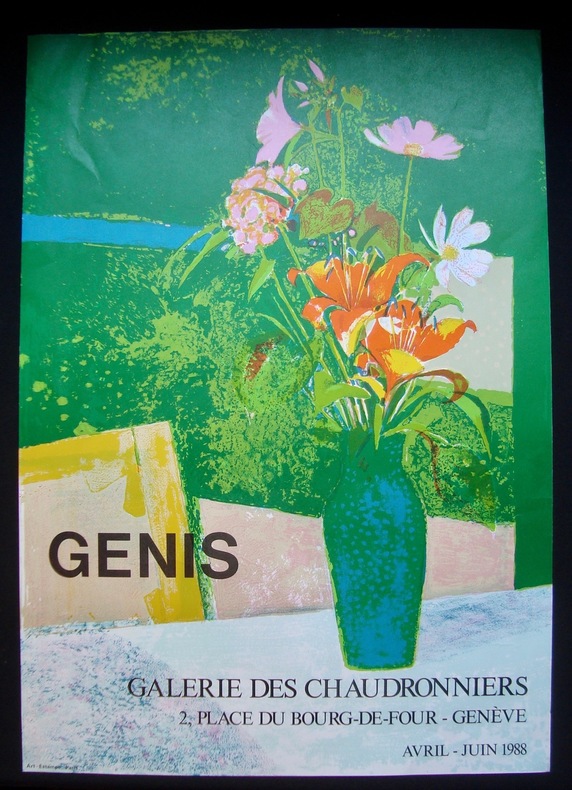
|
|
|
GENTIANE BRUNE
Aquarelle originale réalisée par l’illustrateur PEN pour l’affiche publicitaire de la GENTIANE BRUNE, « tonique, apéritive et digestive ».
Aquarelle originale réalisée par l’illustrateur PEN pour l’affiche publicitaire de la GENTIANE BRUNE, « tonique, apéritive et digestive ». Distribution à Paris, 10 boulevard de Charonne et à Amiens, 63, rue des 3 Cailloux. (22 x 15 cm). Une note précise que le format définitif sera de 90 x 60 cm. Rare.
Bookseller reference : 58C24
|
|
|